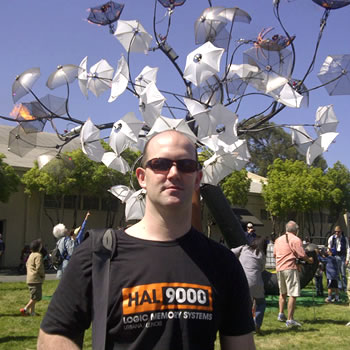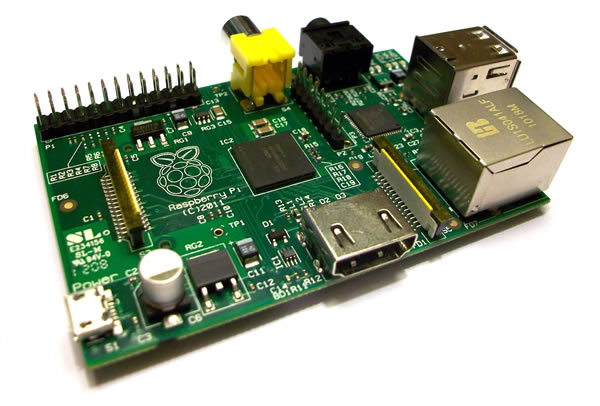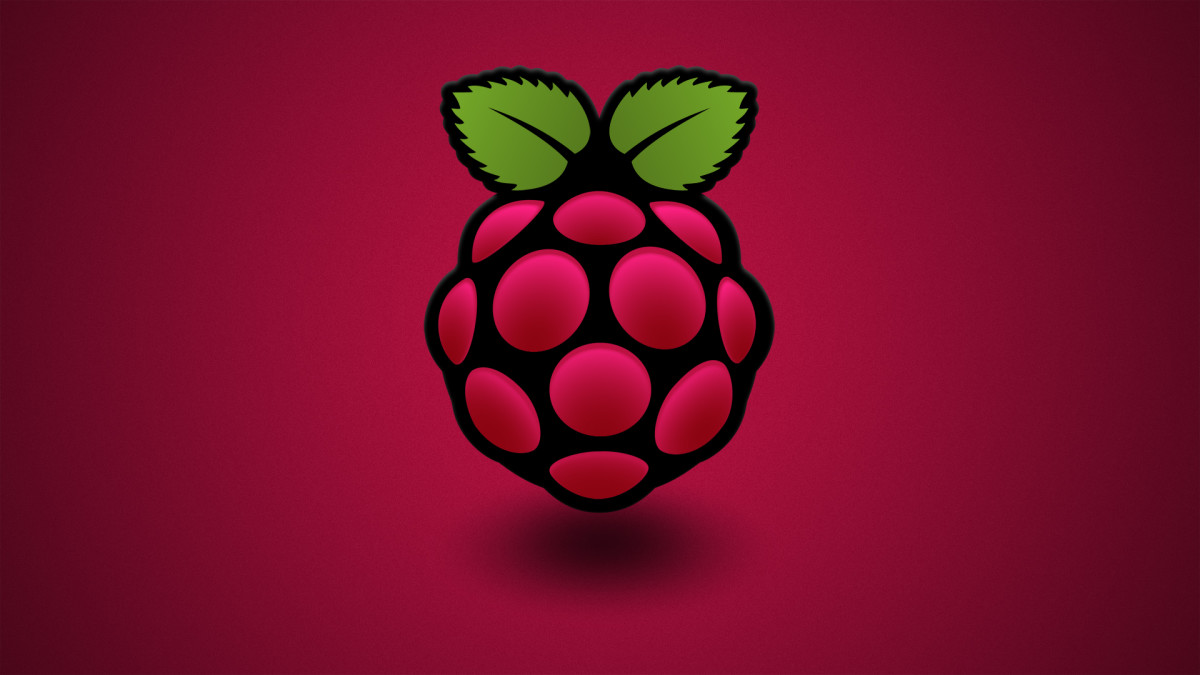
Our interview with Eben is the first on a series of articles we plan to publish in the coming months, where we talk to some of the tech industry's brightest minds, leaders, and visionaries. We are calling this special feature THINK IT.
Eben Upton has had an interesting trajectory both as an entrepreneur and academic, founding a couple of startups over the last decade and a half, as well as acting as the Director of Studies in Computer Science at the University of Cambridge.
Now employed at Broadcom as an SoC architect, his latest "on-the-side" venture combines a little bit of each facet and is perhaps its most ambitious yet: reignite programming in schools with a cheap ($25-$35), compact computing platform that kids could buy themselves. But despite targeting students, his foundation's tiny computer has already captured the imaginations of tinkerers worldwide.
We recently had the chance to put a Raspberry Pi Model B to the test and are now following up with an interview to one of the visionaries behind this non-profit project born in the UK.
TS: First of all, congratulations on the early success of your project! Although users are just starting to receive their Raspberry Pi units now, the level of attention you've been getting is impressive.
Thank you. It's been enormously surprising for us. It's succeeded beyond our wildest dreams I guess.
TS: Tell us a bit about your professional background and how the idea of the Pi computer started.
I've been in Cambridge for 16 years now – it's incredible, longer than I ever planned. I spent a little time in the University of Cambridge when I was younger and did a doctorate in computer science at the Computer Laboratory. While there, a few of us noticed that the number of undergraduate students was declining every year and the things that students knew how to do was declining as well. They knew less every year.
They were still very, very bright, but they had less experience, so you have to spend more time giving them that experience when they come in the door. When you have a three-year course to get someone ready to go into a job or do a PhD it's helpful if they've got a lot of experience when they arrive.
So we had this idea that one of the problems stemmed the rise of the home PC and game consoles to replace the machines we used in the 1980s, the Amigas, BBC Micros, Spectrum ZX and Commodore 64 machines the previous generation learned to program on. I loved to program on my own, I wasn't taught at school. These machines sort of tempted you into programing but that wasn't happening as much anymore.
A lot of the time people focuses on this from an economic angle: it's about what's good for the country. Countries need engineers in order to be competitive. But I always thought of this the other way around, that actually it's about the kids.
We sat down to produce a machine of the sort. Something that was cheap enough that children could buy it themselves or have it given to them as a gift and that was reasonably powerful. We weren't aiming for a retro computer. It took us a long time but what we came up with was the Raspberry Pi.
TS: In what year was the project born?
I started looking into it since around 2006 but the foundation started in 2008.
TS: How many people formed the initial team and how many are working on the project right now?
We have six trustees who are the original founders. We have a much larger group of volunteers working on the project. A number of people are employees of Broadcom who spend their evenings working on it. We also have a number of people who are students of the Computer Laboratory at Cambridge University.
I was at the Computer Laboratory when we started the project and now I work at Broadcom, which provides the chip for the Raspberry Pi. So we have these two kind of "core" places where Raspberry Pi stuff happens and there are volunteers within both organizations working on it. And then we have a larger community of volunteers from all over as well who are doing all sorts of different things, doing new applications for the Pi, looking at the code we release and spotting bugs, or implementing new core features to the device.
TS: I don't mean to put you on the spot here, but how are you managing your role at Broadcom and being the founder of the Raspberry Pi foundation?
Broadcom has been very understanding and very supportive of the Raspberry Pi. The Pi uses a Broadcom applications processor – an ARM based SoC – and on my day job I'm the architect for our next generation ARM based SoC. I was involved in the team that produced the chip that went into the Raspberry Pi and we're now thinking about what chips we're going to have in 2-3 years time. So that's my day job and Broadcom has been very understanding about allowing me to devote a little bit of attention to Raspberry Pi at least for now.
TS: Is it part of your plans to go full time into the foundation in the near future?
Not really. I have this fantastic job with Broadcom. Part of our story with the Raspberry Pi is that we want to give children access to engineering, because engineering is enormously good fun. A lot of the time people focuses on this from an economic angle: it's about what's good for the country. Countries need engineers in order to be competitive. But I always thought of this the other way around, that actually it's about the kids themselves. We're not necessarily doing this to help Britain be competitive. We're doing this because engineering is an enormously fun thing to do and it's sad that children don't have access to this fun thing.
So my day job is enormously good fun. I do engineering everyday and I get paid for it. I have no real desire to step away from that and do foundation stuff all the time. There's going to be a balance between the two.
I'm a ThinkPad guy. Day to day I use a ThinkPad X40. I used to work for IBM and I had my first ThinkPad in 1996 – it had a 486SX-25 processor I think. So I've always been a ThinkPad guy.
(from page 2)
TS: Do you think going as a non-profit has opened more doors than if you had started a private enterprise?
I don't believe that there was any way that we could have done this as a commercial venture. I mean, you see the number of sales and it's easy to think, "Wow, I wish I could make some profit out of that!". You're generating all this value and none of it is going to your wallet. But in practice actually it's fantastic.
It's very helpful when you're approaching component suppliers for them to realize that you're not trying to just make a quick buck or load your own pocket, but rather that you are doing this for charity.
That's part of the reason why people have been very understanding and prepared to sell us relatively low quantities of a certain component. We produced 10,000 units of the Raspberry Pi on our first run, which is a tiny number by consumer electronic standards, yet our suppliers were very prepared to deal with us because they knew that we weren't trying to make a quick buck.
To be honest a lot of us who are involved in the foundation have done entrepreneurial stuff before and have had some success, so it's very nice just this once have it not be about making money but rather for doing something good for other people.
TS: Where does the name Raspberry Pi come from?
Raspberry is a reference to a fruit naming tradition in the old days of microcomputers. A lot of computer companies were named after fruit. There's Tangerine Computer Systems, Apricot Computers, and the old British company Acorn, which is a family of fruit.
Pi is because originally we were going to produce a computer that could only really run Python. So the Pi in there is for Python. Now you can run Python on the Raspberry Pi but the design we ended up going with is much more capable than the original we thought of, so it's kind of outlived its name a little bit.
TS: The idea of a $35 computer that's so capable undoubtedly raised a few eyebrows. Have you suffered hurdles to keep the promise of the low price? What issues were the hardest to resolve?
The main thing here is we didn't do anything unless it was useful to everyone. We get a lot of emails from people asking us for certain features. For example, there are some people who would love the device to have two Ethernet ports, but we didn't do it because it was kind of a minority interest thing – it may be interesting to 10% or 20% of the people buying Pi's but it's not interesting to everyone. There are a lot of things that would be interesting to 10% or 20% of the people and if you start adding them all you'll double or triple the cost.
So we focused on providing the core features that we know everybody needs, which is USB, mouse/keyboard, display, storage, processor, and multimedia. We haven't added a camera, or a built-in display, or more networking, or on-board flash storage, any of those things which could have been very useful to some segment of our population. That's the main thing that helped us keep the price down.

Besides that there are a few particular compromises. For example, the audio, which is kind of an FM radio quality analog audio. We don't have CD quality audio. That would be a place where we could have added maybe a $1 or $2 chip to the device and get better audio but we decided that it was better to just be good enough to keep the price down. We continue to investigate if there are things that we could do in software to make that audio better but we haven't committed that extra dollar or so of BOM cost.
TS: If you wanted to add a new interface to the Pi tomorrow, what would be your #1 priority?
If I could add one thing – for free – I think it would be a camera. The original prototype that we showed had a camera and there was a very strong reaction to that camera. Now, the camera didn't pass the test that I just described, about being useful to everyone. But if there's one thing I could add it would be a camera.
(Shortly after this interview the folks at Raspberry Pi offered a first look at a prototype camera add-on board they're developing for release later in the year. No word on pricing yet, though.)
